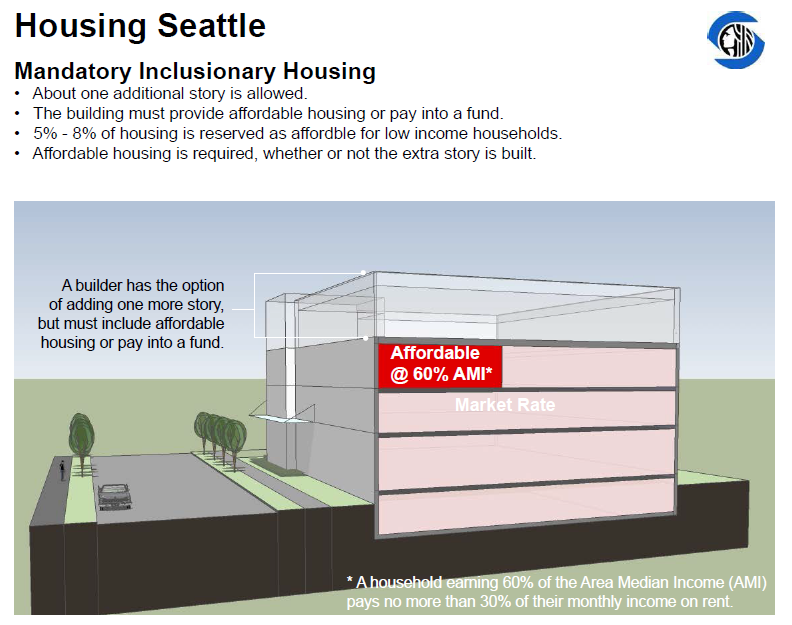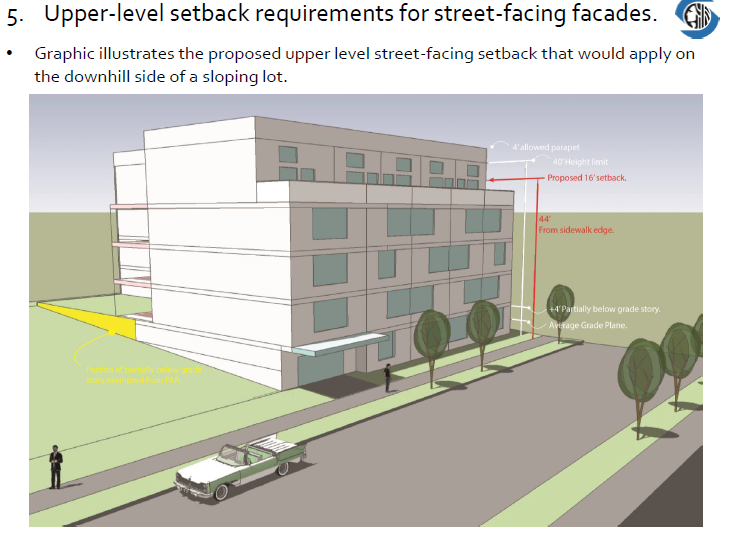What the HALA?: Cassandra and Pollyanna Edition
There’s something I need to point out about the so called “Grand Bargain” struck between some people in the business and development community and non-profit housing community as a result of the Mayor’s Housing Affordability and Livability Agenda (HALA) Committee. I’ll keep doing this even though, I think, my point is mostly being ignored by some who are cheerleading for the Bargain. Let’s start with two images. You can see the details of the bargain in the final framework document.
Here’s the first one, a depiction of how the HALA Grand Bargain would work in a low-rise zone:
Now here is a depiction of what the City Council did in low-rise zones recently over our strenuous objection including a SEPA appeal, a 16 foot set back to the top floor of buildings in the LR 3 zones:
Doesn’t anyone notice this? Sometimes I feel like I’m taking crazy pills!
The same brains that devised a 16 foot set-back to ameliorate the visual impact of “East Block” buildings on the sensibilities of angry neighbors now must go back to that same zone, with the same neighbors, and say, “we’re adding another floor!” Keep in mind that the housing and buildings the Council damaged with their code changes were having zero negative effect on the neighbors other than added needed housing units, increasing supply and thus positively impacting price.
Now the Council has demonstrated a prodigious capacity to hold completely contradictory ideas in their collective brains, like “let’s make housing more affordable by adding additional costs to its production!” But I find it hard to imagine that the same Council that fell all over itself to appease the angry neighbors will suddenly tell those same neighbors, “remember that thing we did to those big, ugly buildings you hate so much? Well we’re not only going to undo that, but we’re going to add another floor! You’re welcome.”
Add to this the fact that from I hear from people who actually build housing in the low-rise zones, adding an additional floor doesn’t add much value to offset locking in the affordable rents that will be required by the bargain. What’s pretty clear in all this is that our efforts to fend off a linkage tax worked, but has yielded a scheme that
- is built on the assumption that new housing and density is still a bad thing needing to be offset with some kind of penalty;
- is tone deaf to the deep hostility and anger boiling in the neighborhoods toward any additional density;
- is inflationary by its very nature, increasing rents in non-rent restricted units to subsidize the inclusionary units;
- is contingent on the City Council going into the neighborhoods to process the bargain; and
- may not add very much additional value or housing.
As I’ve pointed out before, the Bargain has accomplished the feat of pulling the neighbors and non-profit housing advocates apart from one other. However, nobody seems to be acknowledging the gross inconsistency between the trend of Council actions on land use and housing over the last two years and what the Bargain will require. Will the Council now impose these new requirements over what will surely be the objection of neighbors in order to squeeze out a few rent restricted units? Will builders back away from deals in the low-rise zones and elsewhere when the market starts to cool if the changes pass? And if they do build, how much will rents rise across the city to pay for the subsidy? And when it does, will the Council have the intellectual capacity to see that those increases are attributable to the Bargain and resist the urge to regulate, fee, and tax housing yet again?
I guess it depends on who you listen to, Cassandra or Pollyanna.




